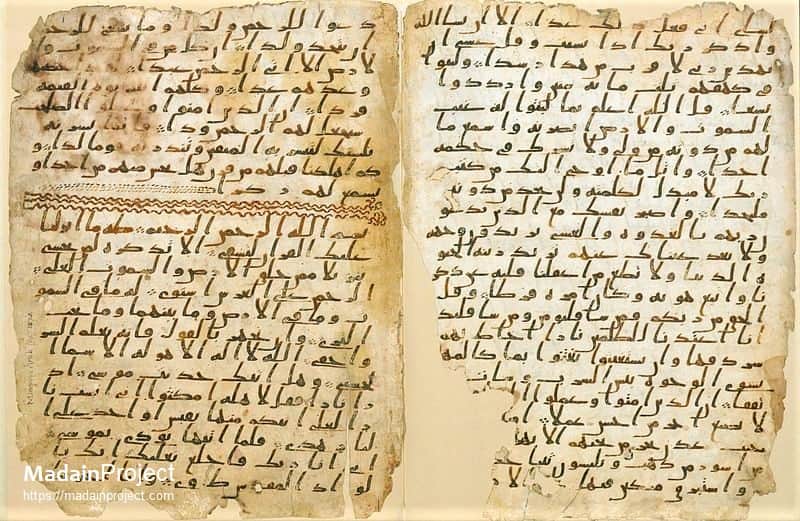The oldest known surviving copies of the Quran are written in the Hijazi script, which was used in the Arabian Peninsula during the 7th century AD. The oldest of these copies date back to the 8th and 9th centuries AD.
One of the oldest known copies of the Quran is the Sana’a manuscript, which is believed to date back to the 7th or 8th century AD. The manuscript, which is written on parchment, was discovered in the 1970s in the Great Mosque of Sana’a, Yemen. It is considered to be one of the most important and accurate copies of the Quran from the early Islamic period and has been extensively studied by scholars.
Another early copy of the Quran is the Tashkent Quran, which is believed to date back to the 8th century AD. This copy of the Quran is written in the Hijazi script and is considered to be one of the most well-preserved copies from this period. It was discovered in Uzbekistan in the 19th century and is now housed in the Tashkent Islamic Institute.
A third one is the Topkapi Manuscripts, it is believed that this copy of Quran dates back to 8th century AD too and it is one of the most valuable and complete copy in terms of the number of pages. It was found in Istanbul, Turkey in the Topkapi Palace Museum.
The Birmingham Manuscript of the Qur’an
Yet another recently discovered copy of the Qur’an is the Birmingham manuscript. The Birmingham Quran Manuscripts are a collection of early Islamic parchment fragments, consisting of two leaves from a Quran manuscript, that were discovered in the University of Birmingham’s Cadbury Research Library in 2015. These leaves were believed to have been written between 568 and 645 AD, making it one of the oldest surviving copies of the Quran in the world.

Believed to be the oldest surviving copy of the Qur’an, Birmingham manuscript contains parts of Surat al Kahfi and Tha-Ha.
Carbon dating and multispectral imaging were used to determine the age of the manuscript and the study of the script and other palaeographic details, suggest that the manuscript was probably written in the 7th century AD, which was within the lifetime of Prophet Muhammad.
The discovery of these fragments caused a great deal of excitement and generated a lot of media attention, with some scholars and Islamic organizations claiming that the manuscript was written by one of the companions of Prophet Muhammad. However, the majority of scholarly opinion suggests that the manuscripts were written significantly later, probably between the late 7th century and early 8th century AD.
The Birmingham Quran Manuscripts are parchment fragments that consist of two leaves from a Quran manuscript. The leaves contain parts of what is believed to be Surahs (chapters) 18 and 20 from the Quran. Specifically, the first leaf contains verses from the end of Surah 18 (Al-Kahf or The Cave), specifically the last three lines of verse 109 to verse 110, and the first four lines of verse 111. The second leaf contains verses from the beginning of Surah 20 (Ta-Ha or Ta-Ha), specifically the first 5 lines of verse 1 to verse 12.
Palaeographic analysis of the manuscripts also revealed that the script is not fully developed, which indicates that the manuscript is from an early stage of the Hijazi script development, which is consistent with the carbon dating results, which suggest a 7th century AD date for the manuscripts.
The script is also considered to be written by an individual scribe, and not a professional calligrapher, and as a result, it has been described as having an “amateur” quality. There are variations in the letter forms, spacing and other features that are common in manuscripts of that time.
In addition, The manuscript also lacks of any diacritical marks or vocalization marks, which are used in later Quranic texts to indicate vowel sounds and other pronunciation. This suggests that the manuscript is from a time before the development of a standardized system of diacritical marks and vocalization, which were later developed to standardize Quranic texts and facilitate reading and recitation.
It is worth noting that these fragments are some of the oldest surviving copies of the Quran known to exist and they show variation in spelling, orthography, and other features when compared to the standard editions of Quran in use today. It could be a good representation of the early form of Quran as well as showing how it was being copied and recited in the early Islamic period.
Nevertheless, the discovery of the Birmingham Quran Manuscripts is considered to be one of the most significant finds in the field of Islamic studies in recent times, as it provides valuable insights into the early history of the Quran and the development of the Islamic script. These manuscripts are important in tracing the early text and the version of Quran as it was in that time and also showing how it was being copied and spread in early Islamic period.
It is important to note that there are other early copies of the Quran that have been discovered, and scholarship in this field is ongoing. While the dates of these manuscripts are estimates, but experts believe them to be from early Islamic period and are considered as the closest representation of the original Quran.




Leave a Reply